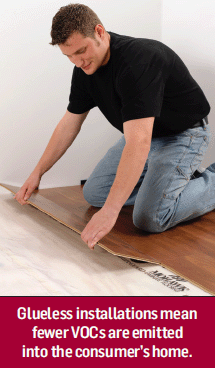BY ROGER FARABEE - Vice president of marketing, Mohawk Hard Surfaces
With all the sustainability and environmental jargon flying around in the industry, determining what is actually green can be difficult. Figuring out what is and isn’t renewable, or what’s environmentally safe or not safe, can be confusing and cumbersome. Sustainability—keeping resources replenished and perpetuated— requires a conscious effort from manufacturers as well as a true understanding of the environmental impact of processes.
Products such as ceramic tile and hardwood are often thought of as sustainable and renewable because they’re not far removed from their original natural sources. But marketing a laminate product as sustainable can be a tougher sell to consumers unless you know the facts about the product’s manufacturing, construction and installation. Fortunately, laminate construction and processes are much greener than most people think. Companies can even gain valuable LEED points by using laminate.
In fact, the ability to earn those LEED points is one of laminate’s most desirable features. LEED—Leadership in Energy and Environmental Design—is a building rating system developed by the U.S. Green Building Council and is the most recognized third-party certification program in the industry for inspecting and ensuring the design and construction of energy-efficient, green buildings. Mohawk’s U.S.-produced laminate, for example, would qualify as an EPP (Environmentally Preferred Product) in all green rating systems because it contains an average of 74% pre-consumer recycled content. So with LEED, it could help a project earn up to four points.
Manufacturers should incorporate environmental initiatives into their laminate production. Some examples include:
Manufacturing: Truly sustainable manufacturing should reuse as much waste as possible and renew it through alternate processes. For example, instead of sending wood waste and rejected product to landfills, Mohawk facilities use it as process heat during laminate manufacturing.
Construction: Mohawk’s U.S.-produced laminate flooring products contain an average of 74% pre-consumer recycled content, which is made up of industry waste. Wood waste that otherwise would be burned or sent to a landfill can instead go into the core boards of the laminate product.
Installation: Laminate is a glueless installation product. That means fewer VOC (volatile organic compound) emissions into the home of the consumer. Sometimes, a laminate floor can be reinstalled up to three times. So instead of throwing it away, it can be reused for another room in the home.
Selling the benefits of laminate to a consumer is multi-faceted and using its environmental advantages will prove to be a differentiator.
With all the sustainability and environmental jargon flying around in the industry, determining what is actually green can be difficult. Figuring out what is and isn’t renewable, or what’s environmentally safe or not safe, can be confusing and cumbersome. Sustainability—keeping resources replenished and perpetuated— requires a conscious effort from manufacturers as well as a true understanding of the environmental impact of processes.
Products such as ceramic tile and hardwood are often thought of as sustainable and renewable because they’re not far removed from their original natural sources. But marketing a laminate product as sustainable can be a tougher sell to consumers unless you know the facts about the product’s manufacturing, construction and installation. Fortunately, laminate construction and processes are much greener than most people think. Companies can even gain valuable LEED points by using laminate.
In fact, the ability to earn those LEED points is one of laminate’s most desirable features. LEED—Leadership in Energy and Environmental Design—is a building rating system developed by the U.S. Green Building Council and is the most recognized third-party certification program in the industry for inspecting and ensuring the design and construction of energy-efficient, green buildings. Mohawk’s U.S.-produced laminate, for example, would qualify as an EPP (Environmentally Preferred Product) in all green rating systems because it contains an average of 74% pre-consumer recycled content. So with LEED, it could help a project earn up to four points.
Manufacturers should incorporate environmental initiatives into their laminate production. Some examples include:
Manufacturing: Truly sustainable manufacturing should reuse as much waste as possible and renew it through alternate processes. For example, instead of sending wood waste and rejected product to landfills, Mohawk facilities use it as process heat during laminate manufacturing.
Construction: Mohawk’s U.S.-produced laminate flooring products contain an average of 74% pre-consumer recycled content, which is made up of industry waste. Wood waste that otherwise would be burned or sent to a landfill can instead go into the core boards of the laminate product.
Installation: Laminate is a glueless installation product. That means fewer VOC (volatile organic compound) emissions into the home of the consumer. Sometimes, a laminate floor can be reinstalled up to three times. So instead of throwing it away, it can be reused for another room in the home.
Selling the benefits of laminate to a consumer is multi-faceted and using its environmental advantages will prove to be a differentiator.
 |